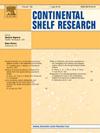Machine learning reveals biological activities as the dominant factor in controlling deoxygenation in the South Yellow Sea
IF 2.1
3区 地球科学
Q2 OCEANOGRAPHY
引用次数: 0
Abstract
Dissolved oxygen (DO) is a crucial element for both biotic and abiotic processes in marine ecosystems, but has declined globally in recent decades. Therefore, there is an urgent need for solid large-scale and continuous estimation of DO concentration in vital ecosystems, such as coastal areas. A random forest (RF) model for DO in South Yellow Sea (SYS) was developed by integrating satellite data and simulation data during 2011–2019. The root mean squared error (RMSE) for the training and test sets were 0.514 mg/L and 0.732 mg/L, respectively. Spatiotemporal distributions of DO of multiple layers in the study area during 2011–2019 were very well reproduced by the RF model and showed a slight decline trend in most SYS areas, while more intense decline occurred in the deep central SYS. The analysis of the mechanisms of DO decline in the South Yellow Sea cold water mass (SYSCWM), located in the deep central SYS, indicates that the deoxygenation here is largely due to biological activities. This finding may have implications for studies on drivers of deoxygenation in coastal areas. Furthermore, integrating satellite data with machine learning models can offer a powerful approach to capturing the continuous spatiotemporal characteristics of ocean parameters over large spatial scales.
机器学习揭示生物活动是控制南黄海脱氧的主导因素
溶解氧(DO)是海洋生态系统中生物和非生物过程的关键元素,但近几十年来,全球溶解氧浓度都在下降。因此,迫切需要对沿海地区等重要生态系统的溶解氧浓度进行大规模、连续的可靠估算。通过整合 2011-2019 年期间的卫星数据和模拟数据,建立了南黄海溶解氧随机森林(RF)模型。训练集和测试集的均方根误差(RMSE)分别为 0.514 mg/L 和 0.732 mg/L。射频模型很好地再现了 2011-2019 年期间研究区多层溶解氧的时空分布,大部分 SYS 区域的溶解氧呈轻微下降趋势,而中部深层 SYS 区域的溶解氧下降更为剧烈。对位于 SYS 中部深层的南黄海冷水团溶解氧下降机理的分析表明,这里的脱氧主要是由生物活动引起的。这一发现可能会对沿岸地区脱氧驱动因素的研究产生影响。此外,将卫星数据与机器学习模型相结合,可以为捕捉大空间尺度上海洋参数的连续时空特征提供一种强有力的方法。
本文章由计算机程序翻译,如有差异,请以英文原文为准。
求助全文
约1分钟内获得全文
求助全文
来源期刊

Continental Shelf Research
地学-海洋学
CiteScore
4.30
自引率
4.30%
发文量
136
审稿时长
6.1 months
期刊介绍:
Continental Shelf Research publishes articles dealing with the biological, chemical, geological and physical oceanography of the shallow marine environment, from coastal and estuarine waters out to the shelf break. The continental shelf is a critical environment within the land-ocean continuum, and many processes, functions and problems in the continental shelf are driven by terrestrial inputs transported through the rivers and estuaries to the coastal and continental shelf areas. Manuscripts that deal with these topics must make a clear link to the continental shelf. Examples of research areas include:
Physical sedimentology and geomorphology
Geochemistry of the coastal ocean (inorganic and organic)
Marine environment and anthropogenic effects
Interaction of physical dynamics with natural and manmade shoreline features
Benthic, phytoplankton and zooplankton ecology
Coastal water and sediment quality, and ecosystem health
Benthic-pelagic coupling (physical and biogeochemical)
Interactions between physical dynamics (waves, currents, mixing, etc.) and biogeochemical cycles
Estuarine, coastal and shelf sea modelling and process studies.
 求助内容:
求助内容: 应助结果提醒方式:
应助结果提醒方式:


